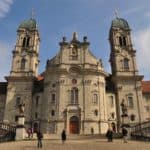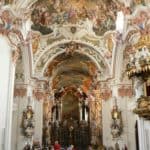Einsiedeln, Switzerland: Shrine of Our Lady of Einsiedeln
The Story of Our Lady of Einsiedeln:
 Located south of Zurich at an elevation of about 3,000 feet is one of the most ancient and revered holy places in Europe. The shrine located here dates from sometime in the 9th Century when a hermit from one of the local monasteries, Saint Meinrad, built a hermitage on what was then open countryside and brought with him a wooden statue of the Madonna.
Located south of Zurich at an elevation of about 3,000 feet is one of the most ancient and revered holy places in Europe. The shrine located here dates from sometime in the 9th Century when a hermit from one of the local monasteries, Saint Meinrad, built a hermitage on what was then open countryside and brought with him a wooden statue of the Madonna.
Meinard was known for giving hospitality to strangers, but unfortunately that led to his death. In January 861, he took in two rather rough-looking travelers and fed them. It turned out that they were thieves, and when it turned out that he had nothing of value, they beat him to death.
Then, in 940, some of the Benedictine Monks turned the hermitage into a small chapel where the statue was kept.
The story now becomes more interesting, as related in some of the ancient documents found here. When the church was due to be consecrated on September 14, 948 two Bishops kneeling before the altar suddenly saw Christ standing at the altar with angels and saints beside him! Then, when one of the Bishops tried to consecrate the church, one of the angels held him back announcing that Christ had consecrated the church the night before. September 14 is now the feast of Our Lady of Einsiedeln and a great day of celebration in the village.
 As previously mentioned, the statue brought by Saint Meinrad was kept in the Church but both the chapel and the statue were destroyed in a fire in 1465, so the statue you see there today is a replica. It is still a source of great devotion, however, and has been blackened by so many candles over the years that is now referred to as the “Black Madonna” as are others throughout the world. Many miracles have been credited to this devotion and the shrine draws several hundred thousand pilgrims each year.
As previously mentioned, the statue brought by Saint Meinrad was kept in the Church but both the chapel and the statue were destroyed in a fire in 1465, so the statue you see there today is a replica. It is still a source of great devotion, however, and has been blackened by so many candles over the years that is now referred to as the “Black Madonna” as are others throughout the world. Many miracles have been credited to this devotion and the shrine draws several hundred thousand pilgrims each year.
Guided tours of the Abbey are available, check their website for times. At least five masses are celebrated daily at the shrine of Our Lady and in the Abbey Church.
On Sundays and public feast days:
8:00 am, and 5:30 pm (at the shrine of Our Lady)
9:30 am and 11:00 am (at the main altar of the Abbey Church)
On weekdays:
6:15 am, 9:30 am, and 5:30 pm (at the shrine of Our Lady)
11:15 am (at the main altar of the Abbey Church)
In addition to the celebration of the Eucharist, the monks celebrate the Divine Office five times a day:
5:30 am Vigils
7:15 am Lauds
12:05 pm Midday Prayer (only on weekdays)
4:30 pm Vespers and Salve Regina
8:00 pm Compline
All services are celebrated in German and/or Latin.
For a Mass in English, pilgrim groups are requested to have their own priest with them. English speaking confessors from the Abbey are available on appointment. The same applies to guided tours on the Abbey grounds.
If you plan to visit Einsiedeln Abbey with a group, or wish to book a mass in English, please contact their pilgrimage office. They are happy to help you.
Of course they have a great gift shop with items made at the Abbey, and there is a Christmas Market that lasts a short time in December.
Traveling to Einsiedeln:
You can reach Einsiedeln by train from Zurich (about 50 minutes) or Lucerne (about one hour). From train station it is about 15 minutes walk to the monastery. Of course you can also reach it by car (No parking is allowed on the monastery grounds, but there are public parking areas nearby). There are a few pilgrimage groups that do include Einsiedeln in their itineraries.
Address: Kloster Einsiedeln, 8840 Einsiedeln, Switzerland
GPS coordinates: 47° 7′ 36.4512” N, 8° 45′ 9.5004” E
Tel: +41 (0) 55 418 61 11 Fax: + 41 (0) 55 418 61 12
email: monastery@kloster-einsiedeln.ch
Click here for the official website (there is an English language option)
⇐ Back to Catholic shrines and places of interest in Switzerland
Article sources:
1. Madden, Daniel M. , A Religious Guide to Europe,Collier Books, 1975.
Photo credits: Wikimedia

